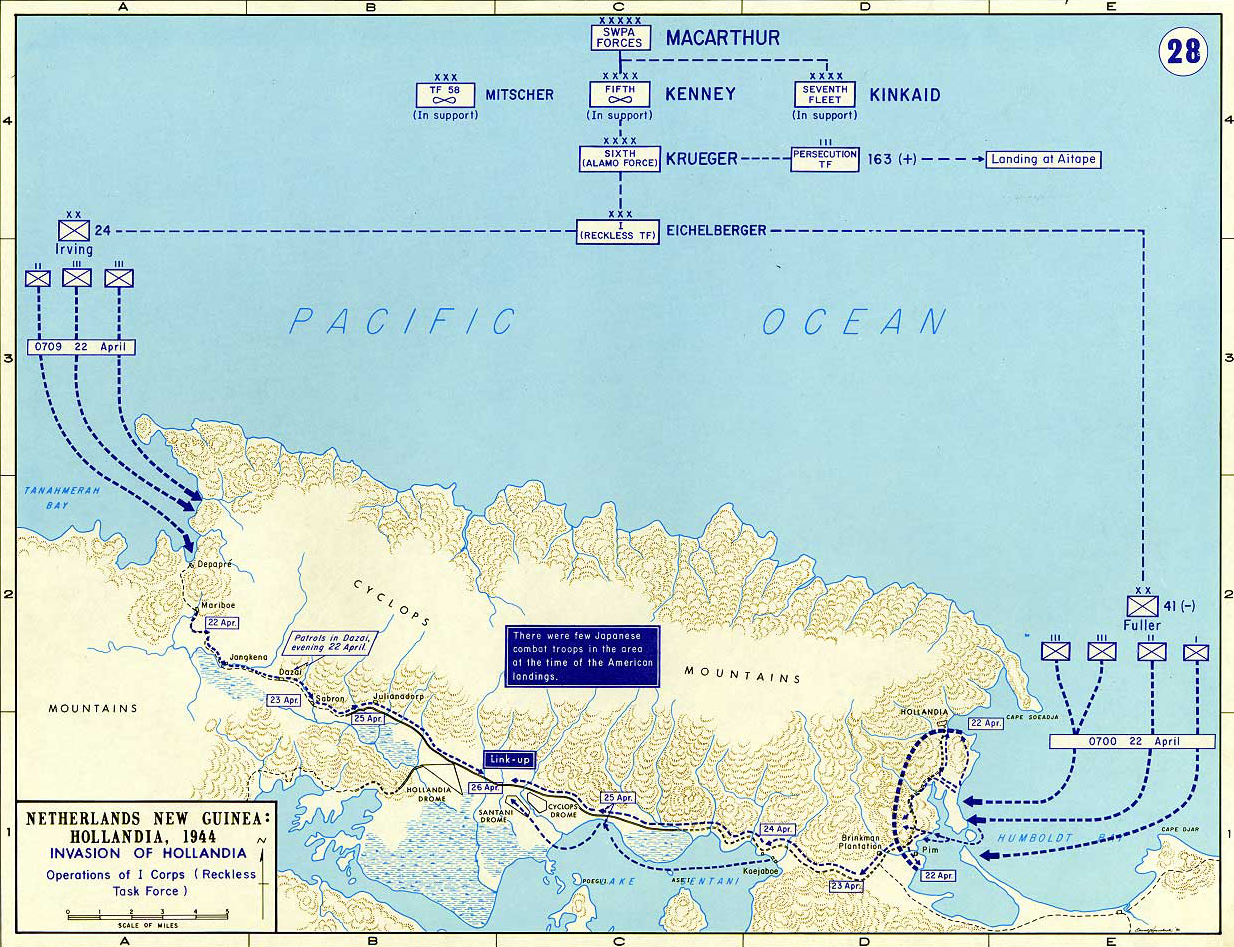Map Description
History Map of WWII: Netherlands New Guine 1944
Hollandia was a port town on the north coast of the Dutch colonial territory Netherlands New Guinea.
During WWII, Hollandia (now Jayapura, Indonesia) was a strategically significant location, especially after its
occupation by the Japanese in 1942 and its subsequent capture by Allied forces in 1944 during
the Battle of Hollandia 22 April - 6 June 1944.
Hollandia served as a major Allied base of operations and headquarters for General Douglas MacArthur after its liberation.
Illustrating:
Invasion of Hollandia, 1944
Operations of I Corps (Reckless Task Force)
The Invasion of Hollandia, conducted from 22-27 April 1944, was directed by General Douglas MacArthur as part of his
"leapfrogging" strategy. This approach aimed to bypass heavily fortified Japanese positions in New Guinea, focusing instead
on less-defended but strategically crucial targets.
Operation Reckless, as it was officially named, targeted the Japanese-held airfields
around Hollandia with the goal of establishing a forward base for subsequent operations in New Guinea and the Philippines.
The assault was spearheaded by I Corps, also known as
the Reckless Task Force, under Lieutenant General Robert L. Eichelberger. It comprised the
U.S. 24th and 41st Infantry Divisions, supported by naval and air units.
A decisive advantage for the Allies came from ULTRA intelligence, which revealed that most of the Japanese forces in the
area had been redeployed to Wewak. This allowed the Allies to strike a lightly defended target and achieve strategic surprise.
The military strategy combined amphibious landings, air superiority, and rapid inland movement. Rather than confronting
major Japanese strongholds like Wewak and Rabaul directly, the operation focused on capturing Hollandia’s critical airfields.
On 22 April, simultaneous landings took place at Tanahmerah Bay and Humboldt Bay, disrupting Japanese coordination and
preventing reinforcements. Pre-invasion bombing raids by the Fifth Air Force had already neutralized Japanese air capabilities,
ensuring uncontested control of the skies.
Once ashore, Allied troops advanced rapidly inland, encountering disorganized resistance and securing the airfields within days.
Combat engineers immediately began restoring the captured airstrips, enabling Allied aircraft to begin operations almost
immediately.
The swift capture and repair of these airfields transformed Hollandia into a major logistical and operational hub,
becoming the site of MacArthur’s new headquarters and serving as a launch point for the eventual liberation of the Philippines.
The operation resulted in over 3,300 Japanese casualties compared to fewer than 200 Allied losses. It underscored the effectiveness
of Allied intelligence, mobility, and joint-force coordination. The successful use of ULTRA intercepts in planning the assault
validated MacArthur’s reliance on codebreaking to shape campaign decisions.
Ultimately, the invasion of Hollandia exemplified the evolving Allied strategy in the Pacific — one that prioritized maneuver,
surprise, and efficiency over attritional combat.
Credits
Courtesy of the United States Military Academy Department of History.
Related Links
About the Second World WarWWII Timelines

